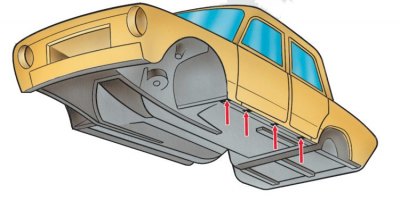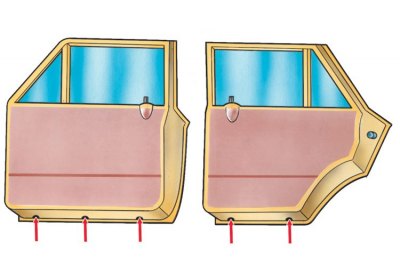
Threshold drainage holes | 
Door drain holes |
The body is the basic and most expensive element of the car. It is made of modern materials and protected from corrosion by high-quality protective agents. The basis for the durability of corrosion protection is laid down by the manufacturer, however, its effectiveness and duration depend on proper care, climatic conditions, the ecological state of the environment and storage conditions.
To avoid scratches on the body paintwork, do not remove dust and dirt with a dry cleaning cloth. It is better to wash the car before the dirt dries with a low-pressure water jet using a soft sponge. In summer, wash your car outdoors in the shade. If this is not possible, then immediately wipe the washed surfaces dry, as spots form on the painted surface when the drops of water dry in the sun. In winter, after washing the car in a warm room, before leaving, wipe the body and door seals dry, as if the remaining drops freeze, cracks may form on the paintwork and the seals may freeze to the doors. It is not recommended to use soda and alkaline solutions, as well as waste water for washing the car, so that the coating does not fade.
Before washing the car, clean the drain holes in the doors and sills. When washing the car, avoid direct water jet on electrical equipment, electronic devices, sensors and detachable connections in the engine compartment. Monitor the condition of the protective covers of detachable connections of electronic units and sensors. If moisture gets in, blow the detachable connections with compressed air and treat with an autopreparation «Unisma-1» in aerosol packaging to protect contacts from oxidation.
During washing, thoroughly wash the flanges of the doors, hood, trunk lid, welds and connections of the engine compartment, trunk and doorways, as the accumulated dirt in these places will lead to the destruction of the protective and decorative coating and to corrosion of the metal.
If signs of corrosion are found (corrosion deposits, local swelling of paint, etc.) clean the damaged area with fine emery cloth to bare metal, treat it with a cold phosphate coating «Phosphacor», cover with primer GF-021 and paint over with enamel from the attached jar.
Chips and scratches on the paintwork, chips of mastic along the wheel arches and on the bottom are associated with a mechanical impact of an operational nature. Traces of corrosion on welding joints and joints of body parts are superficial and can be removed at the initial stage by polishing with PMA-1 or PMA-2 pastes. If measures are not taken in a timely manner to eliminate defects in the protective and decorative coating of an operational nature, this will lead to the development of corrosion under the coating layer, its peeling and swelling.
To increase the corrosion resistance of the body, a special anti-corrosion composition is applied to the closed box-shaped cavities of the thresholds, spars, cross members and other elements of the body base. During the operation of the car, we recommend that the protective coating of the hidden cavities of the body be restored at the maintenance enterprises periodically every 1.5–2 years.
During the operation of the car, the coating on the bottom of the body is exposed to gravel, sand, salt. As a result of this exposure, the mastic and primer are erased, the bare metal rusts. Therefore, regularly monitor the condition of the bottom coating and restore damaged areas in a timely manner.
Before applying protective coatings (primers, mastic) treat rusty surfaces with a compound «Feran».
To keep the gloss of the painted surfaces of the car (especially for vehicles stored outdoors) Polish them regularly with polishing pastes. These pastes close microcracks and pores that have arisen during operation in the paintwork, which prevents corrosion under the paint layer.
To keep the surface of the body shiny for a long time, do not leave the car for a long time in the sun, and also do not allow acids, soda solutions, brake fluid and gasoline to get on the surface of the body.
To avoid stains on the paintwork under the fuel filler door when gasoline gets in, wipe the surface with a clean rag before and after refueling.
Clean plastic parts with a damp cloth. It is not recommended to use gasoline or thinners, otherwise the plastic parts will lose their luster. Of the car preparations for cleaning plastic parts, we recommend using a universal interior cleaner «Dinta» or vehicle «Alva».
Dust from upholstery of pillows and seats remove with a vacuum cleaner. To remove grease stains on upholstery, use an all-purpose interior cleaner «Dinta» or neutral soap and water. At the same time, carefully wipe the rubber seals and the surfaces of the doors and trunk lid in contact with them with a damp cloth.
Clean the windows with a soft linen cloth or chamois. Wash very dirty glass with water and windshield washer fluid (30 cm3 for 1 liter of water).
Due to the unfavorable environmental situation in some areas, there are cases of aggressive effects of individual components from the environment on the protective and decorative coatings of the car. These effects are manifested in the form of a red rash, local discoloration of the outer paintwork, local destruction of the enamel coating of the body.
The reason for the appearance of a red rash is the deposition on the horizontal surfaces of the body of the smallest particles of metal dust suspended in the air, which is glued to the body by corrosion products during moistening with dew. Red rash can be removed with a 5% oxalic acid solution, followed by copious washing with clean water, after which the body must be polished. Without special measures, it is gradually removed by subsequent washes or rains.
Local color changes (spots) external paintwork and local destruction of the enamel coating of the body are the result of exposure to acidic industrial emissions after their combination with air moisture. Such impacts, depending on the severity, are eliminated by polishing or repainting the body.
